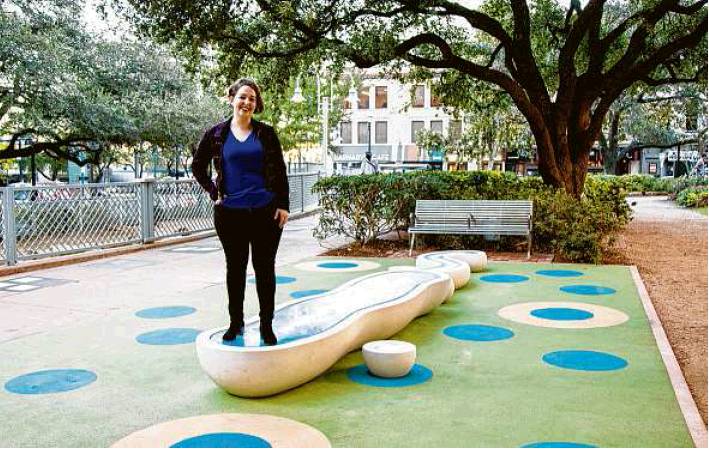ART
Artistic endeavors bring beauty to a concrete world
By Molly Glentzer STAFF WRITER
Public art serves many good purposes, but heading into a somber winter, projects that lift moods are especially welcome.
Francesca Fuchs’ “Yellow Glow” and Falon Mihalic’s “Meander” cheer up those who encounter them while also mirroring the landscape in intriguing ways. Unrelated yet complementary, both new works embrace Houston’s relationship with concrete and can be seen during a bike ride or a hike around the Heights and downtown.
Fuchs’ “Yellow Glow” turns the underside of the North Shepherd overpass between Sixth and Seventh streets into a refined environment of columns with bands of soft yellow paint that fade to gray at the top and bottom. They suggest that bright sunlight might somehow have found its way into that drab space, washing the columns with an elusive flash of light. Commissioned by Radom Capital and Triten Real Estate Partners, the developers of the adjacent M-K-T retail center, “Yellow Glow” is a gift to the city along the Heights Hike and Bike Trail.
Fuchs, who leads the painting program at the Glassell School of Art, primarily produces delicately hued, small-scale canvases of domestic objects. This is her second monumental outdoor work. The first, a mural, created a subtle trompe l’oeil effect of imaginary columns on the facade of Lawndale Art Center in 2018. “Yellow Glow” is painting-as-sculpture, playing with three-dimensional perspective in ways that make me wish every underpass in town could be so transformed.
In some ways, it started with the gray base. Fuchs appreciates the various tones of gray authorities use to cover graffiti that appears on the columns supporting Houston’s vast system of freeways. And most people think of the columns vertically, she adds. “I wanted to go horizontal and make it so they’re somehow dissolving.”
Street art, while colorful, also tends to look chaotic. Fuchs’ project is timelessly meditative. She liked the idea of creating public art during the time of COVID-19 and applied for the M-K-T project because she wanted to make a big gesture outside instead of small pieces in the studio.
The scale of “Yellow Glow” is larger than anything she’s done, including the Lawndale mural. But as with her small paintings, Fuchs still aimed for a simplicity of means. “I’m just doing this through color,” she says, “but the subtlety of what’s happening will be experienced differently from different directions.”
A crew with a mechanical lift gave the columns a base coat of a very particular shade of custom gray that extends from the ground to the beams. Fuchs based the gray on the natural color of the columns but did a lot of testing in her studio to achieve a certain “shift” that creates subtle variations as daylight changes. She and an assistant rolled on the bands of yellow, then brushed in the fading effect.
“It’s quite painterly at the end of the day,” Fuchs says. She starts to call herself “the lady of the invisible,” then thinks better of it. But she does want to catch viewers a bit unaware. “I enjoy my pieces not being overt,” she says. You have to be there and say, ‘Is this something?’ and then, ‘Oh, this is something.’ ”
At downtown’s Market Square Park, Mihalic’s more pop-art like “Meander” hugs the earth with a series of cast-concrete and resin sculptures whose noodlelike form mimics the meandering shape of nearby Buffalo Bayou.
If you’re biking or walking, the park is a few blocks from the Buffalo Bayou Park Trail. While you’re there, hop over to the Preston Street Bridge behind Wortham Theater Center and look for Houston’s most surprising and “secret” public artwork, Dean Ruck’s “Big Bubble,” which also draws attention to the bayou. Viewers activate the work with a small red button that’s in a brick niche. Pressing the button activates a splashy “burp” in the water that makes you wonder what huge living thing is dwelling under the surface.
One of Mihalic’s pieces is bench height, but all three double as play structures for kids who might also be inclined to jump around her rubber lawn of big blue polka dots.
It’s all handmade, says Mihalic, “but the resin is the crown jewel.” Iridescent pigments in the urethane resin shimmer like water, sometimes looking frozen. At night, lights inside the structures amp up the effects. Some of the lines carved into the resin are based on the outline of Houston’s original City Hall, which long ago occupied this plot of land.
Mihalic chose the material for its light-capturing qualities, its color stability and its durability. “It’s actually harder than the concrete,” she says, “but it’s a material that hasn’t been used much in public art.”
Environmental light sculptures have become a bit of a signature signature for Mihalic, the founder of the landscape architecture and public art firm Falon Land Studio. Sometimes she incorporates sensors that translate data into art. Her recent “Bayou Beacon” uses water-quality monitoring data to express the water level and flow of White Oak Bayou on a maplike piece. Created for Sawyer Yards, that one debuted in a space that was deemed not accessible safely during the pandemic; it will be reinstalled in a more open environment in March.
“I have the desire to create moments of wonder and curiosity,” Mihalic says. “I work a lot with abstraction, but ‘Meander’ is associative. People see it and immediately ask if it’s wet. That’s a good question to me, for a piece about water.” She loves that the resin invites people to look closely. “Landscape architecture is all about the totality of a place, but in reality it comes down to small moments,” she says. “That’s captured in the resin. It’s something to get lost in. It’s good for our brains, good to just get lost in the color.” molly.glentzer@chron.com

